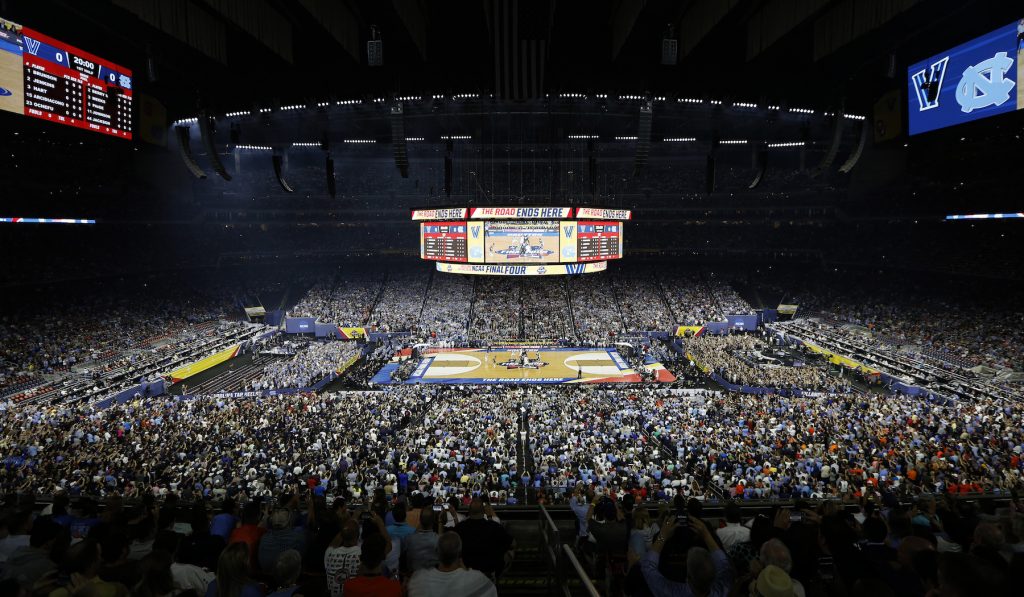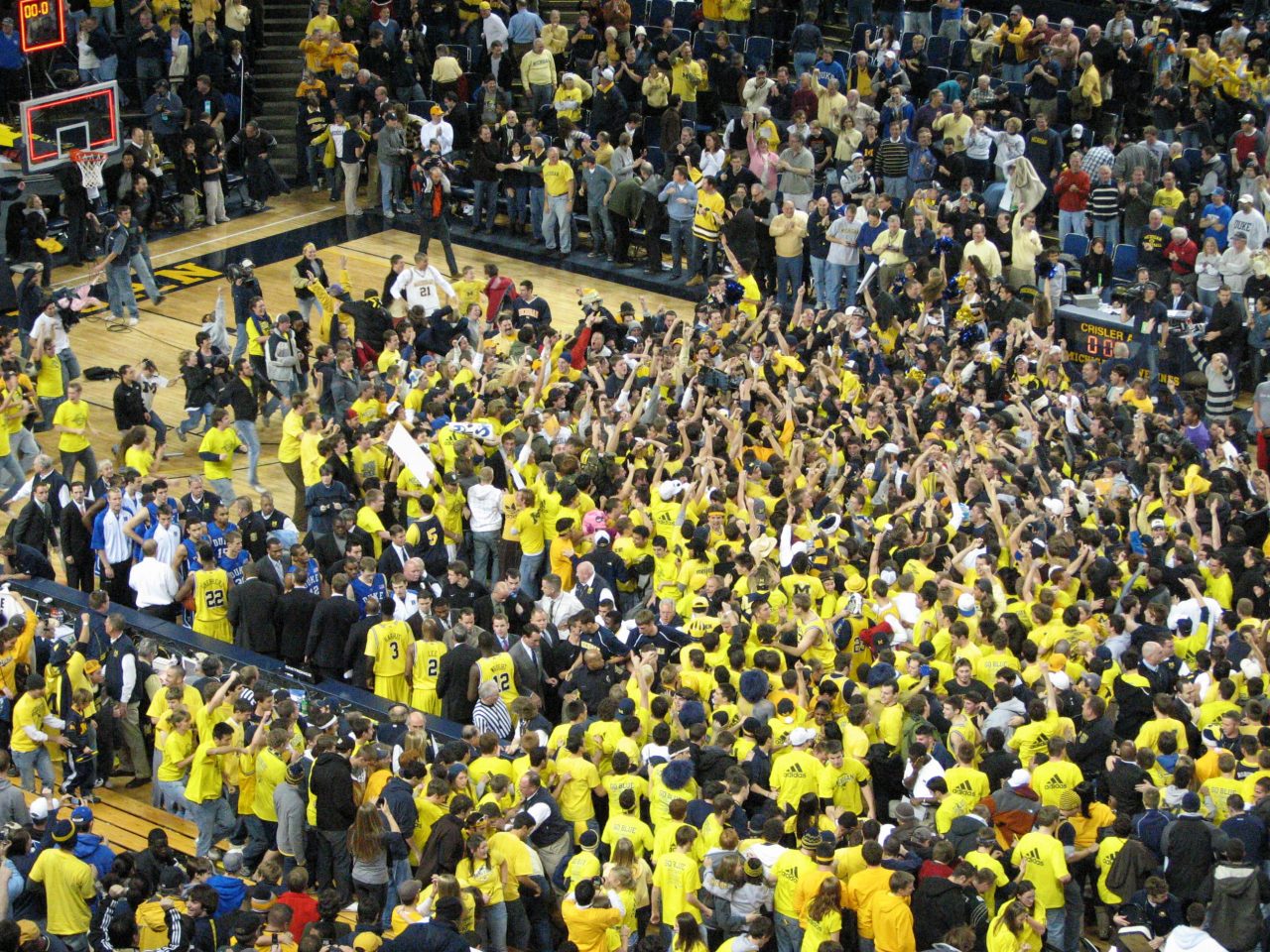
March Madness is expected to bring in $900 million for the NCAA. Here’s where the money goes
67 games. Three weeks. One champion. Oh, and 900 million dollars. America’s annual men’s college basketball extravaganza makes a ton of money.
Each March, 68 teams get to go to the championship tournament. The tournament is pretty nuts – it's affectionately called March Madness – and millions of people show up or tune in to watch. This brings in a lot of money for the league – this year the total should be something like $900 million.
So where does all that money go? To the organizers? The players? Straight back to the colleges involved? The system of sharing out the proceeds of March Madness is pretty complicated, and isn’t without its critics. We try and break it down.
Real fast: how does college basketball work?

There are 351 universities that play in the top college men’s basketball league. Schools are organized into ‘conferences’ which are made up of about 8-16 teams that play against each other regularly throughout the year – they’re normally geographically pretty close to each other. Each conference gets to send its champion to the tournament, and then the rest of the spots are filled by teams that didn’t win their conference but are still pretty good. In total 68 teams get picked for the final tournament.
The tournament is organized by the main governing body for all college sports – the National Collegiate Athletic Association (NCAA). The NCAA gets to keep some of the money from the tournament for itself – this lets it help out all the other sports that don’t make as much money. It then gives the rest of the money back to the schools or conferences. How they do that is the fun (not fun) part...
So let's break down the numbers
How the money should be divided between schools is something people regularly disagree on. Some say the best teams should get all the money – they’re the ones people want to watch on TV after all. Others think it should be split equally between all the teams in the league, win or lose. Still others think the money should try to encourage good things, like better academic performance for athletes.
The $900 million is divided up into pots, which the NCAA then splits by some crazy formula (which we are totally sure is very carefully and scientifically thought out). But this is basically how they do it.
Winners get more money...
This is the part most basketball fans know about. For each game you play in the tournament, your conference gets a bunch of money (the NCAA encourages conferences to split the money evenly among their schools, but not all do). This year each game is worth about $1.6 million so if your school (or a team in your conference) keeps winning, they get lots and lots of money. This is how about 30% of the money is distributed.
...apart from schools with more athletes which get the most money
This money is given directly to schools based on how many sports they compete in and how many athletes on scholarship they have. This pool is actually the biggest; it’s close to 40% of the total.
A smaller pot is shared equally between everyone...
This money is given out to each of the 32 conferences equally. This pot is much smaller – each conference gets about as much from this as they would for winning one tournament game.
... and then there's some money to go to good causes...
This pot is specifically for conferences to do things like promote opportunities for women and ethnic minorities or run drug prevention programs. This pot is only about 2% of the total, or the the equivalent of winning six tournament games.
... and some specifically for helping student athletes
This money is split into two more pots. One is for athletes' academic costs that aren’t covered by scholarships – things like tutoring, summer school and supplies. Health and safety expenses are also included in the ‘academic’ fund.
The other fund is designed to help students who are struggling financially. Students can ask to use the money in the pot for unexpected financial needs – travel to funerals is a common example – but not for recurring costs like rent or food. Part of this money is given to schools with the most athletes, and part is given to schools with more students from poorer families.
But people think there's still stuff missing
They’re colleges, remember
Starting in 2020, the NCAA will start giving more money to schools whose athletes do better in the classroom. The league is planning to set a goal for the number of athletes at a school who eventually graduate with a degree, and give extra money to every school that meets that goal.
The NCAA is sometimes criticized for putting sports above academics, so it seems smart enough that the conference would want to put some actual money on valuing academic achievement. But not everyone’s sure the plan will work. There’s also a fear that putting money on graduation rates will encourage schools to help athletes ‘graduate’ without doing the same amount of work as other students.
Give the players some credit
Right now, all of the money goes either to schools or conferences, who can then spend it on things to help their student athletes. But why not just give some of the money to the players directly?
The league says they value their student athletes, but they also value the idea of amateurism – that the players are students first and athletes second. Paying players would change this, making them closer to employees of the school than students.
But without the players there’s no $900 million to split up in the first place. A lot of people – including many current and former players – think they’re getting an unfair deal. Some have even talked about forming a players' to try to negotiate more benefits with the league.
And what about the fans?
Of the $900 million the tournament brings in, about $100 million is from ticket sales (the rest is from TV deals). This year, ‘cheap’ tickets for a first round game can cost something like $100 each. For students, that’s a lot of money, especially if your team manages to keep winning and play in a few games. If the league wanted, they could provide lower cost tickets to students, or just drop prices for everyone and bring in less money. (Just saying).



